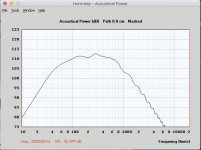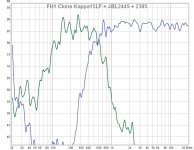Dayton H812 & p audio ph-3220
How do they differ? Dimensions seem very close to each other. But the p audio has cutoff at 500hz. While the Dayton is 800hz.
The Dayton is available domestically and good price. The paudio doesn’t appear to be available domestically
dayton H812 - Dayton Audio H812 1" Exponential Horn 100x60 2-Bolt
paudio ph-3220 - http://www.paudiothailand.com/uploads/pdf/products/PH-3220.pdf
How do they differ? Dimensions seem very close to each other. But the p audio has cutoff at 500hz. While the Dayton is 800hz.
The Dayton is available domestically and good price. The paudio doesn’t appear to be available domestically
dayton H812 - Dayton Audio H812 1" Exponential Horn 100x60 2-Bolt
paudio ph-3220 - http://www.paudiothailand.com/uploads/pdf/products/PH-3220.pdf
Last edited:
I second that question to GM about baffle being curved....do you just mean curved towards ear level of the listening position?
'cutoff' is very subjective.. they look to have the same dimensions, so i would personally go for the dayton
These are more or less identical.
The theoretical horn cutoff, according to Salmon's family of horns, is probably around 500Hz.
Dayton states "useable to 800 Hz" which in practice is the lowest XO limit for many 1.75" diaphragm, 1" exit drivers.
The theoretical horn cutoff, according to Salmon's family of horns, is probably around 500Hz.
Dayton states "useable to 800 Hz" which in practice is the lowest XO limit for many 1.75" diaphragm, 1" exit drivers.
Last edited:
GM, any example(s) of such system > ".... that start up high and ~curve down at the radius of the speaker/LP distance...."?
Did you experience a Saturn V launch live???
That must have been one of the most impressive events ever.
The Rocketdyne F1 is mighty, with 1.5 million pounds of thrust... and the Saturn V had 5 of those.
I'm a big fan of angled high wall/ceiling speakers to much better control reflections, floor bounce, etc., and when one has a stack of horns, curving them in an arc to optimally focus them at the LP same as line arrays and some super high end multi-ways are done.
My system intentionally put the [mid] bass horns at seated ear height with the subs acting as a box stand and only the big WG tilted down and of course a four way would have curved more and had the subs been taller, then the [mid] bass horns would have been tilted, but folks just stack them dead ahead no matter how far away, etc.. Indeed, for so long I thought folks stood to listen till I some along with the whole room.
Anyway, if I were to do a big multi-way again, I'd start at the ceiling and work my way down.
Yes, Apollo 11; it was scheduled close enough to my BD that we took some vacation and stayed with relatives in Orlando [with a new baby girl it was made plain that it wasn't a suggestion] and long story short, it's not what you know, but who you know and my uncle got me a place at the press, etc., 3 mile stands and he took my place at the public's 5 mile. I forget what the SPL increase was, but the hearing protectors wasn't enough for my youthful ears.
Yes, those engines were something else and having seen the aftermath of a test firing at Marshall Space Flight Center in Spring '67 I can attest that they didn't realize just how powerful it was.
GM
true point oohms.
thanks Ro808. I'll go the dayton.
I do already have a pair of paudio ph-4220, but realized it wont nicely fit in current enclosure (too wide). Then check the frequency response between the ph-4220 and ph-3220.. the later seems noticeably more linear... apparently Shindo Japan uses the ph-3220 is their high end speaker design.
ph-4220: http://www.paudiothailand.com/uploads/pdf/products/PH-4220.pdf
ph-3220: http://www.paudiothailand.com/uploads/pdf/products/PH-3220.pdf
thanks Ro808. I'll go the dayton.
I do already have a pair of paudio ph-4220, but realized it wont nicely fit in current enclosure (too wide). Then check the frequency response between the ph-4220 and ph-3220.. the later seems noticeably more linear... apparently Shindo Japan uses the ph-3220 is their high end speaker design.
ph-4220: http://www.paudiothailand.com/uploads/pdf/products/PH-4220.pdf
ph-3220: http://www.paudiothailand.com/uploads/pdf/products/PH-3220.pdf
The PH-3220 and similar horns sold under different labels, is a basic exponential horn. Loved by many diy folks. In Europe the Celestion branded version is popular, because it's cheap, like the Dayton > between 10 and 15 Euros.
Last edited:
What 'claims'?
GM
That his driver, in his specific application, does 35-18k.
Is 12-18k....just a bunch of resonances? Yes, with.... 😉
Last edited:
Cool! Seems reasonable and surprised Altec never developed it further. Is it destined for retail sale?
GM
GM
I don' t know all the specific details either, but still a little too much to reveal.
Last edited:
No PM, GM?
Yes, it will become, or is available as part of a complete loudspeaker system.
The naked driver is probably not available seperately, but who knows.
Yes, it will become, or is available as part of a complete loudspeaker system.
The naked driver is probably not available seperately, but who knows.
Last edited:
I'm a big fan of angled high wall/ceiling speakers to much better control reflections, floor bounce, etc., and when one has a stack of horns, curving them in an arc to optimally focus them at the LP same as line arrays and some super high end multi-ways are done.
My system intentionally put the [mid] bass horns at seated ear height with the subs acting as a box stand and only the big WG tilted down and of course a four way would have curved more and had the subs been taller, then the [mid] bass horns would have been tilted, but folks just stack them dead ahead no matter how far away, etc.. Indeed, for so long I thought folks stood to listen till I some along with the whole room.
Anyway, if I were to do a big multi-way again, I'd start at the ceiling and work my way down.
GM
When I had my mid/high horns below the ceiling, they just did not sound right. Now I realize, that it was most probably due to not tilting them enough. Interesting point about starting from the ceiling - I actually should be able to do this with my 4 way - and it should allow me to to add two more bass horns🙂
Now you're thinking right! 😉 Hard to have too much system efficiency, just a point of diminishing returns.
Note that IME virtually every horn needs at least some mouth damping and some need mass quantities of it, but once done properly those near boundary reflections disappear along with a lot of termination distortion reflections back to the throat. Add a plug like Dr. Geddes does and much [all?] of the throat, driver nasties don't make it down the pipe.
GM
Note that IME virtually every horn needs at least some mouth damping and some need mass quantities of it, but once done properly those near boundary reflections disappear along with a lot of termination distortion reflections back to the throat. Add a plug like Dr. Geddes does and much [all?] of the throat, driver nasties don't make it down the pipe.
GM
Did anyone ever try extending existing horns? The horns that don't have roundovers and smooth transition to the baffle could quite easily be extended with wood panels.
Another question I have is regarding using a front loaded horn like in the La Scala. Would it be feasible to have that run up-to 650 to 700 Hz? I've done some Hornresp simulations (using 15PR400), and with a bit of tuning and tweaking you can get the response smooth up-to that range. The question is how it would sound?
Another question I have is regarding using a front loaded horn like in the La Scala. Would it be feasible to have that run up-to 650 to 700 Hz? I've done some Hornresp simulations (using 15PR400), and with a bit of tuning and tweaking you can get the response smooth up-to that range. The question is how it would sound?
Attachments
Sometimes better, sometimes worse.Did anyone ever try extending existing horns? The horns that don't have roundovers and smooth transition to the baffle could quite easily be extended with wood panels.
4real: Here is my FH-1 clone (very similar fold to LaScala) with 600 Hz crossover. I cannot say a bad word about the sound. Actually, it improved slightly when I turned it 90 degrees, so that the split was placed horizontally. I cannot find the raw measurement without crossover, but there was definitely enough output up to 700 Hz.
Now I use a straight front horn for this band and I must say it is again slightly better.
Now I use a straight front horn for this band and I must say it is again slightly better.
Attachments
Did anyone ever try extending existing horns? The horns that don't have roundovers and smooth transition to the baffle could quite easily be extended with wood panels.
Another question I have is regarding using a front loaded horn like in the La Scala. Would it be feasible to have that run up-to 650 to 700 Hz? I've done some Hornresp simulations (using 15PR400), and with a bit of tuning and tweaking you can get the response smooth up-to that range. The question is how it would sound?
Beginning at age 18 after auditioning a Heathkit HH-1-C Legato, I've made a crusade/mini-career of it, though mostly have limited my forum 'soapbox' on the subject to just foam horn extensions made from open cell trail pads [AKA camper's mattress] or similar.
Sure, just change the throat area, initial horn flare as required. As long as you don't exceed a 2:1 CR, it's normally near enough to a full size throat.
GM
Last edited:
- Home
- Loudspeakers
- Multi-Way
- Is it possible to cover the whole spectrum, high SPL, low distortion with a 2-way?

